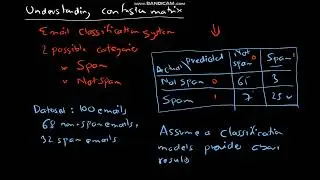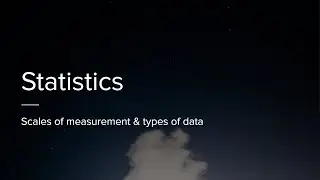Introduction to Statistics: Key Concepts and Applications in Computer Science | Beginner's Guide
Welcome to our course on "Introduction to Statistics for Computer Science Undergraduates"! In this first video, we explore the fundamental concepts of statistics and delve into their practical applications in the field of computer science. Whether you're a beginner or looking to refresh your knowledge, this video is the perfect starting point.
Key Concepts Covered:
1. What is Statistics?
Statistics is the science of collecting, analyzing, interpreting, presenting, and organizing data. It helps us make sense of data and use it to inform decisions.
2. Basic Concepts of Statistics:
Population: The entire group you want to draw conclusions about. Example: All users of a social media platform.
Sample: A subset of the population used to represent the entire group. Example: 1,000 randomly selected users from the social media platform.
Variable: Any characteristic or attribute that can take on different values. Example: Age, gender, and number of posts made by users.
Data: The actual values collected from observations or measurements. Example: Ages of the selected 1,000 users.
3. Descriptive vs. Inferential Statistics:
Descriptive Statistics: Summarize and describe the features of a dataset. Example: Calculating the mean, median, and mode of test scores.
Inferential Statistics: Make predictions or inferences about a population based on a sample of data. Example: Using a sample of voters to predict the outcome of an election.
4. Applications of Statistics in Computer Science:
Algorithm Analysis: Evaluating metrics like time complexity and space complexity. Example: Comparing the average run times of different sorting algorithms on various datasets.
Machine Learning: Using statistical methods to develop models for prediction and classification. Example: Using linear regression to predict house prices based on features like size, location, and number of bedrooms.
Data Mining: Discovering patterns and relationships in large datasets. Example: Identifying purchasing patterns from transaction data to recommend products to customers.
Artificial Intelligence: Creating models that can make predictions and decisions based on data. Example: Developing a recommendation system for movies based on users' viewing histories and ratings.
Network Security: Detecting anomalies and potential security threats by analyzing patterns in network traffic. Example: Monitoring login attempts to detect unusual patterns that may indicate a cyber attack.
5. Real-World Example: Spam Filter
Data Collection: Gather emails and their labels. Example: Collecting 10,000 emails where 5,000 are labeled as spam and 5,000 as not spam.
Descriptive Statistics: Summarize the data to understand common features of spam emails. Example: Calculating the frequency of certain words or phrases in spam vs. non-spam emails.
Inferential Statistics: Use the sample data to train a model that predicts whether new emails are spam or not. Example: Applying logistic regression to determine the probability of an email being spam based on word frequencies.
6. Descriptive vs. Inferential Statistics Examples:
Descriptive Statistics:
Summarizing the test scores of a class of students by calculating the mean, median, and mode.
Creating a histogram to visualize the distribution of ages in a population sample.
Inferential Statistics:
Using a sample of voters to predict the outcome of an election.
Conducting a hypothesis test to determine if a new drug is more effective than an existing one based on trial data.
Learning Objectives:
Understand the basic concepts of statistics: population, sample, variable, and data.
Differentiate between descriptive and inferential statistics.
Recognize the application of statistics in various computer science fields, including algorithm analysis, machine learning, data mining, AI, and network security.
Learn about the practical use of statistics in developing tools like spam filters.
Join Us:
This course is designed to provide a solid foundation in statistics, specifically tailored for computer science students. Subscribe to our channel and hit the notification bell to stay updated with our latest videos. If you find this video helpful, don't forget to like, share, and comment below with any questions or topics you'd like us to cover in future videos.
#Statistics #ComputerScience #MachineLearning #DataScience #AI #learninghub #AlgorithmAnalysis #NetworkSecurity































